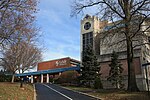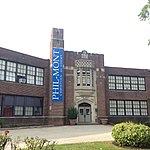Whitemarsh Hall
1920s architecture in the United States1921 establishments in Pennsylvania1980 disestablishments in PennsylvaniaBuildings and structures demolished in 1980Demolished buildings and structures in Pennsylvania ... and 9 more
Former houses in the United StatesGeorgian architecture in PennsylvaniaGilded Age mansionsHorace Trumbauer buildingsHouses completed in 1921Houses in Montgomery County, PennsylvaniaNeoclassical architecture in PennsylvaniaNeoclassical palacesPalaces in the United States

Whitemarsh Hall was a large estate located on 300 acres (1.2 km2) of land in Wyndmoor, Pennsylvania, United States, and owned by banking executive Edward T. Stotesbury and his wife, Eva. Designed by the Gilded Age architect Horace Trumbauer, it was built in 1921 and demolished in 1980. Before its destruction, the mansion was the third largest private residence in the United States. Today, it is regarded as one of the great losses in American architectural history. Despite the name, Whitemarsh Hall was located in Springfield Township, not in Whitemarsh Township which borders Springfield to the west.
Excerpt from the Wikipedia article Whitemarsh Hall (License: CC BY-SA 3.0, Authors, Images).Whitemarsh Hall
Clodion Court, Springfield Township
Geographical coordinates (GPS) Address Nearby Places Show on map
Geographical coordinates (GPS)
| Latitude | Longitude |
|---|---|
| N 40.0936 ° | E -75.1982 ° |
Address
Whitemarsh Hall Pavilion
Clodion Court
19038 Springfield Township
Pennsylvania, United States
Open on Google Maps








